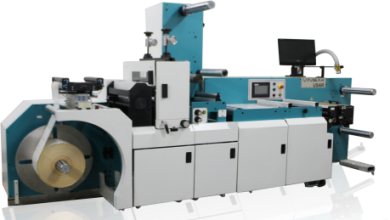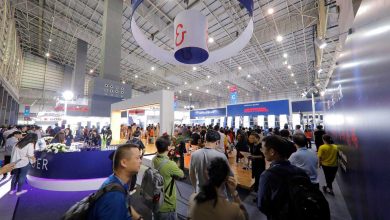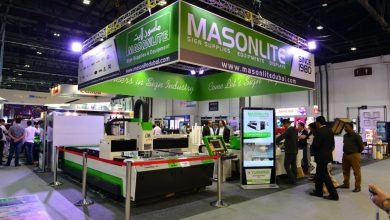Round Up On Technologies Displayed At SGI 2015
Flaar Reports’ team headed by Dr. Nicholas Hellmuth were very active during the SGI 2015. This report is a wrap up on interesting technologies displayed at the show. SGI has become a learning ground for people who are looking for solutions within signage and digital printing technologies.
SGI 2015 had pretty constant traffic. Some other expos have embarrassing low attendance the first day, and then peak the second or third day. Expos in USA often have low first day and low last day (if a weekend in Las Vegas or Orlando especially). But the attendance at SGI was good each of the three days.
The first year I attended SGI, I was by myself. Then we brought a second person. Now SGI has grown to the point that to cover the entire inkjet printer and signage creation workflow, it really helps to have a team of three experienced individuals. So this report on SGI 2015 will cover more topics since we had enough people to look at everything.
UV-cured printers: lots of options
DigiMatrix Technologies exhibited a combo transport belt dilli NEO TITAN 1604D-WV and a substantial roll-to-roll printer, the dilli NEO TITAN RTR 3204D. Both Copatra Graphics and Agfa itself had a total of three UV-cured printers.
The Saga Digital team, Abdallah Ghalayini, Mehdi Berrada Baby, and Massoud Saad, showcased the VUTEk GS3250 LXr Pro and H1625 LED plus diverse other products.
Fujifilm showed their flatbed and their roll-to-roll. The complete list of every UV-cured printer would not fit in a magazine article, so the entire list, with specs, we have in a separate FLAAR Report.
Solvent Printers
Eco-solvent (Epson and many other Chinese made brands) and mild-solvent (Seiko, represented by Matej Dittrich) are still alive and well. Ampla (from Brazil) was present for the first time.
It will be interesting to see the day when there are more UV-cured printers than solvent printers. But today in 2015, and until some other new ink becomes available, solvent and UV-cured are what 80% of the print shops use around the world. Sepiax and all the other “print on everything” inks (such as Staedtler Lumocolor ink) did not survive out in the real world. None of the “bio” solvent inks were successful either. HP is the only company in the world which has put enough R&D funding and enough perseverance to move their latex ink forward. And the other crucial factor, unless an ink company has a functional printer partner, merely discovering some great new ink chemistry has proven to result in market failure in every single instance over the last ten years.
Textile Printers & T-shirt printers
Maria Renee Ayau of FLAAR Reports team covered the diverse selection of wide-format textile printers plus lots of T-shirt printers. D.G.I. had their good Korean quality textile printers on exhibit. Altogether there were 13 brands of textile printers at SGI 2015, a definite growth over 9 brands last year. For T-shirt printers there were both toner options (OKI booth) and pigmented ink versions.
MEMJET
Last year Saga Digital exhibited their RTI Vortex printer. That was sold, so the only Memjet printer to inspect this year was of Gongzheng. Frankly the output was impressive (as were the Chinese scroll paintings featuring village scenes and horses. I studied art history at Harvard and it was precisely this kind of high quality Chinese art, which was featured in one of the courses.
I really like new technologies such as Memjet. But the question will be to what degree can these dye ink printers compete with PageWide technology of HP? This is why it is essential for FLAAR to visit printing companies which have a Memjet installed, to document how it is doing.
After-market Inks
About half the major brands of after-market inks did not have their own corporate booth. Their inks were either in a distributor booth, or rebranded under another name by their local distributor. So Pablo Martinez spend many hours taking notes on which inks were present.
The ink brands we know the best are those where we have visited their factories and world headquarters: Sam Ink, STS Inks, and Hongsam. Sam Ink had a new booth this year: Fortune7. We visited the headquarters of Fortune7 to document the continued growth of Sam Ink worldwide.
There will be a separate FLAAR Report listing every single ink brand noticed during the three busy days at SGI. But to really understand an ink we need to be brought to the factory and then to visit end-users. Durafos is an example of an ink where we would like to know more about their products.
Media and other Printable Substrates
There are so many diverse kinds of printable materials that you can spend an entire day visiting the booths of substrate manufacturers or distributors. SGI had a nice diversity. We at FLAAR Reports are interested in thick and rigid materials: ACM, foamboard, honeycomb, Coroplast and related brands; plus giclee, wall covering material, and all the other kinds of printable material.
 Print shops tend to stick to tried-and-true media. They know this media inside out. To use a new media requires lots of experimentation, which is tough in a busy print shop. So we at FLAAR are working on seeking out, finding, and then mentioning some of the innovative media. For example, I really like some of the sparkle media for wall coverings. Factories in Korea and China both produce great examples.
Print shops tend to stick to tried-and-true media. They know this media inside out. To use a new media requires lots of experimentation, which is tough in a busy print shop. So we at FLAAR are working on seeking out, finding, and then mentioning some of the innovative media. For example, I really like some of the sparkle media for wall coverings. Factories in Korea and China both produce great examples.
Most booths ran out of swatch books already by the second day, but we collected a suitcase full of swatch books nonetheless, and we will be issuing entire FLAAR Reports on printable materials.
We always enjoy visiting with people we know, such as Gopi Kumar Menon, Chief Operating Officer of TechNova. We have visited their facilities over a decade ago, and thus would enjoy returning to see everything that is new.
Cutters of all kinds
Flatbed cutters, CNC routers, plasma cutters, CO2 laser engravers, as well as hand-operated trimmers were all present at SGI. We especially like any machine which can cut material so this piece can be joined with others to create a giant 3-dimensional object.
Laminators and applicator tables
Several brands of traditional laminators were present as well as three European brands of (laminating) applicator tables. I did not notice any coaters but these are an important part of finishing workflow.
LED, LCD, Dynamic Digital Signage
I spoke with Mohamed Ghalayini of media mea in the booth of SAGA Digital. Otherwise, aside from seeing the Minions animated movie on LED screens in a Chinese booth, this is definitely a printer-focused expo.
What is new?
90% of the people who stopped me in the aisles to say hello, asked “what have you seen which is new.” There are two sets of answers: what was not exhibited any earlier year, and what has been around but which I did not notice or did not have time to study in detail in earlier years.
In SIGNTRADE area there were two Ricoh printers which use a kind of dye sublimation ink which is specifically for polymer coated aluminum plaques. So you can print wall plaques for restaurants, as but one example. I have not noticed this printer at any other expo.
ChromoJet had a printer which offered eco-solvent and textile ink in the same printer. But it was not clear to what degree you had to purge one to use the other. But if there are two totally different sets of ink tubing; and two totally different sets of printhead nozzles for each ink, purging would only be needed to clean one so it did not clog during non-use. The only way to recommend such an atypical system would be to visit the factory demo room, and then to visit an actual print shop out in the real world, which had one.
Another notable innovation at SGI was the attractive “inflatable” booth.
What about 3D printers?
Lots of people asked me about 3D printers. My reply was that “3D printers” per se are not printers; they are extruders or additive, or subtractive manufacturing devices. Few use printheads. Although there are industrial 3D machines for house component manufacturing, there are currently no 3D signage printers. 3D printers (with printheads) are for architectural models, just a few centimeters high. Or for museum exhibits (of comparable few centimeter height).
 If you need 3D signage you can produce plenty of innovative signs with a dedicated flatbed from Canon Oce, Fujifilm, Agfa, Swissqprint, (or comparable). The EFI VUTEk booth often exhibits vacuum thermal-formed multi-dimensional signage. This year Fujifilm booth had the complete system on exhibit.
If you need 3D signage you can produce plenty of innovative signs with a dedicated flatbed from Canon Oce, Fujifilm, Agfa, Swissqprint, (or comparable). The EFI VUTEk booth often exhibits vacuum thermal-formed multi-dimensional signage. This year Fujifilm booth had the complete system on exhibit.
Plus with honeycomb sandwich board, a flatbed printer, and an Aristo, Kongsberg, Zund or comparable cutter you can create 3D images as large as an entire life-sized tree. So when asked about 3D “printers” I prefer to focus on the real world of 2015 and the immediate future. Probably by 2020 there will be 3D machines for signage, but not yet.
I would also recommend sign makers visit the DigiMatrix Technologies to see their robotic machines for sculpturing truly 3D signage. These were exhibited in their DigiRobotics section at SGI.
Raised Relief and Spot Varnish
I personally like the raised relief effect which several UV-cured flatbed printers can produce. You can produce stained glass window effects. You can also produce Braille (raised lettering and raised numbers). You need to coat it with something to keep the raised edges from being chipped off when the office or building cleaning crew tries to clean it.
If you do raised relief combined with spot varnish you can achieve close to a “3D effect” and at the size of a sign or impressive graphic display. So this is another example of innovative multi-dimensional signage which has absolutely nothing to do with “a 3D printer.” 3D printers are great for architectural models, for reproducing movie heroes. And other 3D extruding technologies are ideal for making engine and other mechanical parts (additive manufacturing). But to produce 3D signage, your best tool (at present) is a dedicated flatbed printer.
What was very clearly not exhibited
Although the most common question was “what have you seen,” actually in many ways a more telling question is, “what is not visible any more.”
There was no Chinese latex ink printer. There was no Mimaki latex ink printer. Thus it was healthy sign to see Fujifilm exhibit their latex ink printer. Of course there were plenty of HP latex printers. HP has clearly won this market niche situation because HP was consistent: they kept pushing latex ink from day one. Merely launching a nice alternative latex printer is rather clearly not enough.
There were zero SUV printers (Solvent UV); not even the add-on retrofitted variety (adding a light bar to a Roland or Mutoh). Here again, SUV failed (worldwide) because it was merely launched with normal traditional PR agency PR releases. There was no independent outside evaluation to document the benefits and features. Amazing all the R&D money and factory time to produce SUV and then to simply not follow-through. Sepiax at least gained traction; Sepiax ink failed because they stuck too long to Epson printheads, and Sepiax never had a strong printer manufacturer as a partner (because of the Epson printhead focus).
There were not many wide-format UV-cured roll-to-roll printers in booths of Japanese manufacturers: only one UV-cured flatbed in the booth of Mimaki. In the booth of Roland, Mutoh, and Mimaki their primary UV offerings were desktop UV-cured sizes (none roll-to-roll). The Fujifilm Acuity LED 1600 was a nice exception; this has the higher build quality Dimatix (Spectra) printheads. Otherwise, most of the entry-level roll-to-roll UV-cured printers were made in China.
Most reports on an expo understandably feature what was visible. But to really learn the trends, it is essential to know what exists in a factory or distributor demo room, but what is not exhibited at an expo.
General Comments
I also like the three-day period for Sign Middle East in Dubai. SGIA in USA ten years ago was four days; they intelligently switched to three days already many years back. Graph Expo in Chicago continues to be too many days (four is too many for an expo which has shrunk as much as they have). Drupa is the best example of excessive days, probably because the expo is operated by the city of Duesseldorf, which seeks profit from hotel and restaurant income. Drupa at eight days would be plenty. 14 days was obviously excessive for 2012 and dropping it to 11 days at least is better, but eight or nine days would be more realistic.
If you have a print shop, or in-house printing, or are a distributor or manufacturer, anywhere in the Middle East, adjacent Africa and southern portions of Eastern Europe we at FLAAR Reports wholeheartedly recommend attending SGI 2016, Sign and Graphic Imaging Middle East, in January 2016.
Plus, if you are part of any significant international company, which operates in key places around the world, the Dubai area is crucial to learn what is happening here. Winning the 2020 world expo for Dubai will cause things to continue to expand in this part of the world. Ironically the master plan for the world expo presentation was done by Hellmuth, Obata + Kassabaum (HOK Architects).
Dubai city is friendly, very safe, clean, and hospitable. Although there are hundreds of web sites to show you the malls and everything else, FLAAR Reports will be issuing a new report on “Visiting Dubai” based on being driven around the emirate for two days after the expo (plus the previous six years of short visits).
Dubai is a great place to reward your colleagues by bringing them here. Dubai is a dream come true for shoppers. There are plenty of places for children as well: so bring your family also. In other words, Dubai is a significant part of the world and attending the pertinent expo here is definitely worth the flight.





